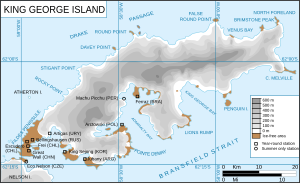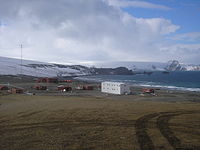Fildes Peninsula: Difference between revisions
Created page with "thumb|right|300px|View of the peninsula from Maxwell Bay {{territory|British Antarctic Territory}} The '''Fildes Peninsula''' is a p..." |
|||
| Line 23: | Line 23: | ||
{{reflist}} | {{reflist}} | ||
[[Category: | [[Category:Headlands of King George Island]] | ||
[[Category:Palaeontological sites of the British Antarctic Territory]] | [[Category:Palaeontological sites of the British Antarctic Territory]] | ||
Latest revision as of 23:24, 14 February 2020

The Fildes Peninsula is a peninsula four and a half miles long that forms the south-western end of King George Island in the South Shetland Islands of the British Antarctic Territory. It was named from association with nearby Fildes Strait by the UK Antarctic Place-Names Committee in 1960.


Description
The peninsula is the most extensively snow-free coastal area in summer on the island, most of which is permanently covered by ice. It is separated at its tip from Nelson Island by Fildes Strait, only 400 yards wide at its narrowest. It is bounded on its south-east coast by Maxwell Bay, which is also known as Fildes Bay, and on its north-west by the open waters of the Southern Ocean.
Geologically, the peninsula is a tableland made up of old coastal landforms, with numerous rocky outcrops and an average height of 100 feet above sea level.[1] Research stations on the peninsula include Chile’s Base Presidente Eduardo Frei Montalva and Profesor Julio Escudero Base, China’s Great Wall Station, Russia’s Bellingshausen Station and Uruguay’s Artigas Base.
Running E-W between Fildes Peninsula, King George Island, and Nelson Island, was known to the nineteenth-century sealers; charted and named Filde's [sic] Strait or Sound by Capt. Robert Fildes, a sealing captain from Liverpool, who visited the South Shetland Islands in the brig Cora in 1820-21, and in the brig Robert in 1821-22, and who prepared the first comprehensive sailing directions for the islands.
Location
- Location map: 62°10’56"S, 58°56’53"W
Antarctic specially protected area
Eight separate sites on the peninsula have been collectively designated an Antarctic Specially Protected Area (ASPA 125) largely because of their paleontological values. The area contains outcrops with fossils dating from the Late Cretaceous to the Eocene, including footprints of both vertebrate and invertebrate animals as well as plant fossils with impressions of leaves and fronds, trunks, and pollen grains and spores.
Sites comprising the ASPA are Fossil Hill, Holz Stream, Glacier Dome Bellingshausen, Halfthree Point, Suffield Point, Fossil Point, Gradzinski Cove and Skua Cove.[1]
References
- ↑ 1.0 1.1 "Fildes Peninsula, King George Island". Management Plan for Antarctic Specially Protected Area No. 125: Measure 6, Annex. Antarctic Treaty Secretariat. 2009. http://www.ats.aq/documents/recatt/Att424_e.pdf. Retrieved 2013-09-29.